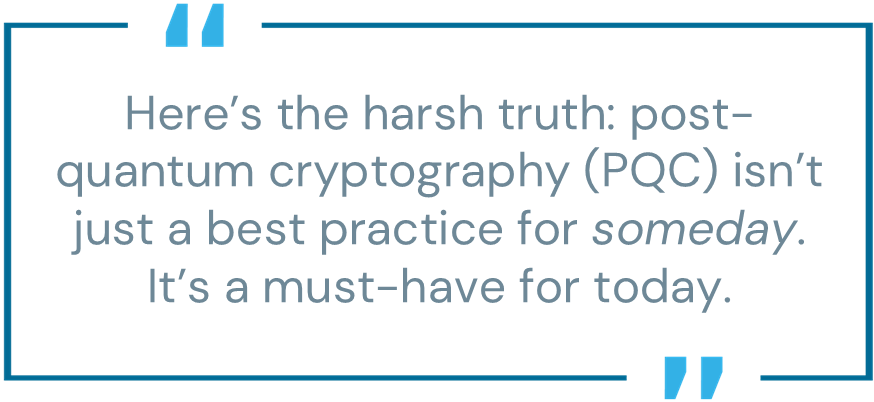
Quantum computing isn’t just coming—it’s barreling toward us, flipping the rules of cybersecurity like a table in a bad action movie fight scene. And it begs the question every CISO and IT security professional should be asking right now: Are we ready for the quantum leap?
While this groundbreaking technology promises extraordinary advancements, from AI breakthroughs to disease modeling, a darker shadow lurks beneath its potential. Quantum computers threaten to outsmart and dismantle today’s most robust cryptographic safeguards, leaving sensitive data exposed, like an open vault in a busy bank.
The implications are enough to make even the most hardened IT security professional pause. But here’s the good news: you’re not powerless. With the proper preparation today, you can anticipate tomorrow’s quantum computing risks and prevent them from becoming your organization’s Achilles’ heel.
Recent Quantum Developments: More Than a Chip Off the Old Block
Industry titans are rapidly racing toward quantum supremacy, and recent quantum chip advancements feel like something straight out of science fiction. These breakthroughs are not just theoretical; they are happening today and reshaping the landscape of computational power.
Here are some of the most notable advancements:
- Google’s Willow claims to solve computational problems in seconds that would take classical supercomputers septillions of years. Yes, “septillions.”
- Microsoft’s Majorana boasts next-gen stability for qubits, overcoming a persistent quantum computing hurdle through the creation of an all-new state of matter that isn’t solid, liquid or gas, but rather a unique arrangement of particles known as a topological state.
- Amazon’s Ocelot introduces scalable architectures that slash error correction by up to 90% and shorten the practicality timeline by up to five years.
The short window and unrelenting pace of these advancements means quantum computing could render RSA, ECC and other public-key cryptography methods obsolete far sooner than anticipated.
And your encrypted data? It’s likely already at risk. Threat actors employing “harvest now, decrypt later” strategies are collecting encrypted data today, with the intention of cracking it once quantum power goes mainstream.
Think about that for a second. The information you’re encrypting right now could already be vulnerable to compromise unless you have the right security controls in place.
The Imminent Post-Quantum Challenge
Here’s the harsh truth: post-quantum cryptography (PQC) isn’t just a best practice for someday. It’s a must-have for today. The National Institute of Standards and Technology (NIST) has taken this seriously, prioritizing the rollout of quantum-resistant cryptographic standards.
Yet widespread adoption remains as sluggish as a Monday morning before coffee. Why? Many organizations are still underestimating just how imminent this problem is. They’re stuck in “it’s a later-me-problem” mode.
But what’s really at stake isn’t just encrypted data. It’s also one of the most critical pillars of modern cybersecurity—one that tends to fly under the radar in the quantum computing conversation: machine identities.

Securing Machine Identities in the Quantum Era
Machine identities—like TLS certificates, SSH keys and API tokens—are the fundamental building blocks of secure communication between systems, applications and IoT devices. These identifiers authenticate innumerable processes and transactions daily, ensuring your payment systems, data supply networks and customer portals operate without interference.
But what happens when quantum algorithms obliterate the cryptography underpinning these machine identities? Malicious actors could hijack machines, pose as legitimate systems and completely upend your networks. If you think ransomware demands are devastating now, wait until attackers can spoof infected systems at the scale of AI at quantum speeds.
It’s the corporate equivalent of handing burglars a master key to every door in your organization.
Quantum Security: Protecting Machine Identities for the Future
According to a recent survey of 1,200 IT and security decision-makers, 58% of teams recognize the importance of comprehensive machine identity security in the seismic shift to post-quantum cryptography. Yet, some still fear it’s already too late to start their transition.
However, the road to a quantum-secure future can’t be paved with duct tape and good intentions. It requires thoughtful strategy, intentional action and relentless innovation.
Here’s a practical roadmap to help safeguard your organization:
1. Conduct a Cryptographic Inventory
First things first. Map your cryptographic assets (certificates, keys and their underlying algorithms). You can’t protect what you don’t know exists, so catalog everything.
2. Prioritize Machine Identity Security
Identify your most critical and vulnerable machine identities. If a bad actor cracks their encryption, what’s the worst that could happen? That scenario should guide your priorities.
3. Adopt Crypto-Agility
Quantum-resistant cryptography won’t be a one-and-done solution (new standards continue to emerge). Equip your systems now with crypto-agile certificate management so you can pivot to updated algorithms when needed without major overhauls. Trust us, scrambling to re-engineer systems in crisis mode isn’t fun, and more mistakes are bound to happen.
4. Collaborate with Experts
Now’s not the time to DIY your quantum security plans. Engage with trusted vendors and industry groups aligned on post-quantum standards and proven machine identity security practices.
5. Hybrid Cryptography is Your Safe Bridge
Implement hybrid cryptographic methods that blend classical encryption with quantum-proof techniques. This ensures a smooth transition while protecting your operations during the interim.
6. Automate Lifecycle Management
Yesterday’s strategies can’t handle tomorrow’s problems, which means manual processes for certificate and key rotations won’t cut it. Automation tools streamline certificate renewals and help ensure compliance with emerging PQC standards.
7. Monitor Quantum Advancements
Stay informed. Quantum computing evolves monthly, if not daily. Ensure your IT team or vendors are tracking developments in quantum capability and cryptographic recommendations.
The Urgency of Quantum: Act Now
Quantum computing isn’t slowing down. Nor should you. By acting decisively now to secure your machine identities and cryptographic infrastructure, you won’t just survive the quantum leap; you’ll thrive in its wake.
Kaitlin Harvey is a digital content manager at CyberArk.























